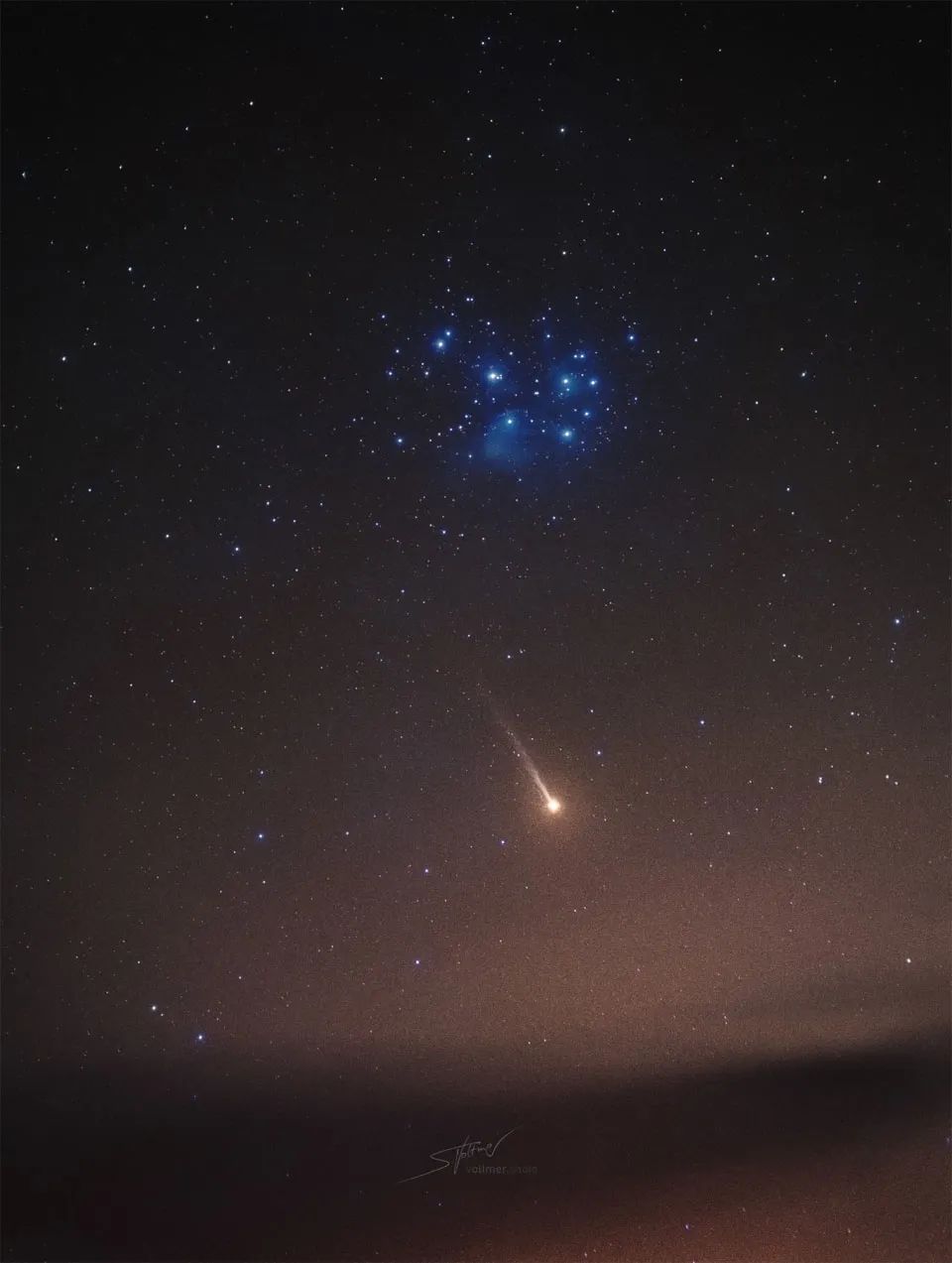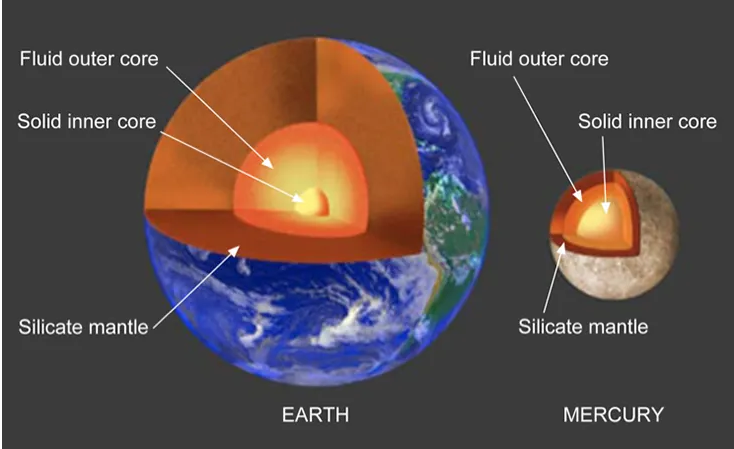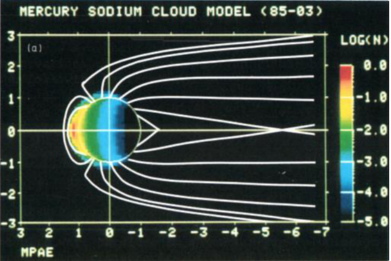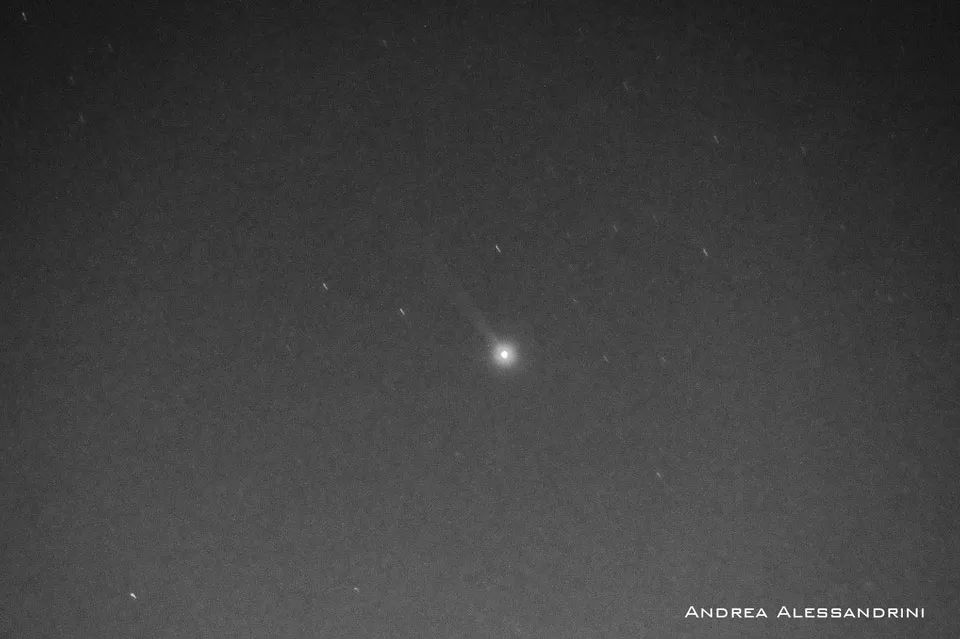The long tail is not necessarily a comet, or Mercury!
Author:Institute of Physics of the Ch Time:2022.08.15
Mercury

This is a picture taken on April 27, 2022 in La Palma Island, Spain. The picture above is the famous star group. The celestial body with a tail below is not a comet, but Mercury. Observing this photo carefully, we will find that Mercury's tail is yellow. Students with the elemental cycle table in the previous life know that this is the phenomenon that sodium is excited. Essence

Figure 1. La Parma Island is located on the Ghana Peninsula. It is the astronomical observation location after Hawaii.
This photo derives two questions: Why does Mercury have a tail? Why is it sodium tail? We can simply solve these two problems. Like a comet, Mercury will have a tail because of the sun blew, especially as the closest planet to the sun, the sun wind is more violent; sodium tail indicates that the surface of Mercury is rich in sodium, so the sodium tail can be formed. So why is it rich in sodium? This is a good problem, and this problem will eventually point to Mercury's origin. To solve this problem, we need to have some understanding of Mercury.
Mercury's scientific history
Before the telescope invention, people knew very little about Mercury, and even Mercury Ling could not observe it. Ganisi first observed Mercury Ling Ri in 1631. In the 20th century, with the use of large telescopes and some instruments, people had a better understanding of Mercury. Scientists have found that there are many similarities between the surface conditions of Mercury and the moon: using the optical meter to measure the brightness of Mercury, and scientists finally analyzed some characteristics of Mercury's surface soil. These characteristics are very similar to the moon, and Mercury's soil is even more even more. Dark. Through the polarization meter's soil, Mercury has evidence of the existence of ring -shaped mountains. In addition, Mercury has a characteristic that the moon does not have, and beyond everyone's imagination -Mercury has the atmosphere: astronomers have tried many ways to discover the existence of Mercury atmosphere. In the end, Sailor No. 10 provided the most solid in 1976 to provide the most solid evidence of. However, this atmosphere is not the atmosphere in our cognition, but an outer layer: constantly leaving Mercury from it, and sodium is naturally one of them.
Unexpectedly, the sailor No. 10 also found that Mercury has a stable magnetic field, and it is a global magnetic field with a strength of 1%of the earth magnetic field. Mercury has a melting core consisting of metal such as iron and nickel. It is about 3/4 of Mercury in diameter and 57%of Mercury (the earth is 1/2 and 17%, respectively). In addition, Mercury's density is only slightly lower than the earth, but if the impact of gravity compression is excluded, Mercury can be regarded as the most dense planet. This special situation exceeds the normal state of the planet in the solar system. Scientists have questioned: What is the reason?

Figure 2. Comparison of Mercury kernel and Earth kernel
Mercury forms a hypothesis
The most widely accepted theory is the giant collision falseness [1]. This hypothesis believes that there is no difference between Mercury and other planets in the early days and other planets, but it is hit by a planet with 1/6 of Mercury. Due to the low speed of Mercury's escape, and the relative speed between the collisions between the planets on the track of Mercury tracks High, this impact stripped most of the crusts and mantles of Mercury, which caused Mercury to have a huge proportion. Regarding Mercury's big collision theory, it further pointed out that Mercury's initial may be transferred to today's track after being collided with the position of today's asteroid belt. In this sense, Mercury and the moon's similarity have further improved, because the most widely originally originally originally originally originally originally originally inferior of the moon is also the collision theory.

Figure 3. Moon: Do I really have a relative?
Another hypothesis believes that Mercury may be affected by the original solar nebula. In the late stages of the star cloud, Mercury's location temperature may be as high as 2500-3500 ° K. Such temperature can melt most of the rock mantles and take them away [ 2]. There is also a hypothesis that the sun has hindered Mercury's accumulation in the early stage of Mercury, which has led Mercury to get a sufficiently thick crust, and the detection of Mercury's enlightenment from 2011-2015 found that potassium and sulfur and other substances on the surface of Mercury surface were found. The content is higher than expected [3] [4], which is a challenge for big collisions and Nebula hypotheses. Perhaps it is the third hypothesis victory. However, further discussion requires new detectors, science is constantly advancing in self.
Forecast and discovery of sodium tail
An important relationship is that the composition of Mercury's outer layer is related to the composition of the crust, so scientists can infer the chemical composition of Mercury crust from the research of outer space. Explain some phenomena of its space. This is why scientists are so interested in Mercury atmosphere.
In 1985, Drew Potter and Tom Morgan discovered the existence of sodium while detecting Mercury's atmosphere. [7]. How does these sodiums produce? Some scholars believe that this is a substance from the Mercury shell and meteorite impact, and Mercury's own high metal content has also become an important source of sodium. Spraying sodium to the outer layer is the result of the combination of multiple processes such as hot evaporation, photon excitation, impact evaporation and ion sputtering.

Figure 4. Visible solar spectrum and Fu Lang and Fei Lang in the range of light. Two D lines are the famous "sodium dual line"
However, the interesting place is here. Each of these processes has its own time and space dependence, and most of them cannot accelerate sodium to escape. Will it form a sodium tail? Two scholars simulate the effects of solar radiation on sodium atomic trajectories that occur from different surfaces. They concluded that as long as the initial speed is greater than 2 km/s, the sodium atom can obtain sufficient energy from the radiation acceleration to form a comet similar to comets The sodium tail. Figure 5, 2km of sodium brightness distribution, this is a paper illustration from 1986

In 2000 and 2001, they finally observed the predicted Mercury sodium tail. The reason why it is so difficult to observe is because Mercury is near the sun all year round, and can only be observed within half an hour before the sunrise during the sun. They found that the acceleration of the sodium tail of the solar radiation finally caused the speed of the sodium tail at the end of the sodium tail to 11 km/s, and the horizontal speed was 2-4 kilometers per second. According to their estimates, the total flux of sodium sodium is about 1 × 10 ²³ atom/second, which corresponds to 1%-10%of total productivity on the earth. The sodium tail coming out has reached such a level. At the beginning, the shooting of sodium tail was relatively vague. With the optimization of scientific instruments, we got this beautiful picture today.
Figure 6 A photo of a sodium tail in May 2020, it seems that good photos are a powerful later stage

However, the students who had built a scientific building in the last life knew that the top of their head may be just two dark clouds at first, but it may suddenly be the dark clouds. The distribution of sodium in time and space is rich in diversity (low emotional quotient: complexity and even random); as a ion, it is closely related to Mercury's magnetic ring; in addition, scientists also found that scientists also found Radiation acceleration does not seem to provide complete energy; and the relationship between ion sputtering, meteorite evaporation, etc. (There are many dazzling things that are dazzling and difficult to organize language)
Due to the restrictions on Mercury's obtaining information, scientists can only establish more connections through limited information, which may be a way to confront the internal volume.
Mercury
We seem to know a lot about Mercury now, but we seem to know nothing ~

References
[1] Benz W, SLATTERY W L, Cameron A G W. CollishingAl Stripping of Mercury's Mantle [J]. ICarus, 1988, 74 (3): 516-528.
[2] Cameron a G W. The Partial Volatilization of Mercury [J]. ICarus, 1985, 64 (2): 285-294.
[3] https://www.csmonitor.com/sclence/2011/0929/messenger-s-message-from-Mercury-time-to-REWRE-TEXTBOOKS
[4] https://www.chemistryworld.com/news/messenger-ds- light- on-mecurys-Formation/3002463.article
[5] Hunten d m, morgan t h, sheMansky d e. The Mercury Atmosphere [J]. Mercury, 1988: 562-612.
[6] Killen R, Cremonese G, Lammer H, et al. Process that promot and deploy the exosphere of mercury [J]. Space science reviews, 2007, 132 (2): 433-509.
[7] Smyth w h. sodium atmosphere of mercury. (Title only) [c] // bulletin of the American Asstronomomical Society. 1985, 17: 712.
[8] Potter A E, Killen R M. Observations of the Sodium Tail of Mercury [J]. Icarus, 2008, 194 (1): 1-12.
Reprinted content only represents the author's point of view
Does not represent the position of the Institute of Physics of the Chinese Academy of Sciences
If you need to reprint, please contact the original public account
Source: Stone Popular Science Studio
Edit: Cloud Kaiye
- END -
The 3rd Guangdong Provincial National Science Quality Competition online competition officially laun

In order to thoroughly implement the Regulations on the Science and Technology of ...
The CR400AF-A Fuxing EMU can do a third-level maintenance in Chengdu!

On July 18, the Chinese Academy of Railway Sciences officially announced the revie...